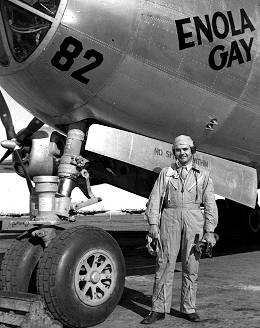The Enola Gay in History and Memory
by Christine Girardin
With the 60th anniversary of the atomic bombings fast approaching, commemorative events and symposia are being planned across the globe in places as diverse, yet symbolically significant, as Hiroshima, Nagasaki, Tinian, London, Tokyo, Washington, and Los Alamos. While forthcoming books by historians Tsuyoshi Hasegawa, Gerard DeGroot, and Martin Sherwin and Kai Bird will advance the scholarly criticism of the bombings and show that viable alternatives for quickly ending the war without a U.S. invasion of the Japanese homeland existed, the bombs’ defenders, including Gen. Paul Tibbets, the pilot of the Enola Gay, will also be out in force. Tibbets, echoing a refrain made popular by President Harry Truman, insists that he never lost sleep over that decision. Interestingly, the 1952 Hollywood film, Above and Beyond, on which Tibbets consulted, shows him unable to sleep on the night before the bombing of Hiroshima as he grappled with the profound consequences of what he was about to do. As historian Peter Kuznick explains, those consequences included not only the wanton slaughter of over 200,000 people in Hiroshima and Nagasaki, and the condemning of additional scores of thousands to a life of torment, but the inauguration of the nuclear era in a fashion that Truman and others understood could ultimately end life on the planet. The major mobilization this May around strengthening the Non- Proliferation Treaty during the review meetings at the United Nations is designed to reverse the spread of nuclear weapons and the further increase in nuclear weapons states to make sure that that dire prospect is never realized. Japan Focus introduction.
TITUSVILLE — There were 12 men onboard the B-29 that dropped the world’s first atomic bomb in war, annihilating 70,000 people that day in Hiroshima, Japan, and killing about 130,000 more in the aftermath. Historians still disagree about whether the bombing was necessary to prevent the loss of more lives in battle, but the man who flew the aircraft on Aug. 6, 1945, remains proud of his role in the closing days of World War II.

Col. Paul Tibbets with the Enola Gay on Tinian prior to takeoff for Hiroshima
“I regretted it was necessary, but to me it was necessary to do it. I tell everybody I never lost a night’s sleep over it,” said retired Gen. Paul W. Tibbets, who is telling tales of those heady days and meeting fans this weekend at the 28th annual Tico Airshow in Titusville.
Col. Paul W. Tibbets stands next to the B-29 Superfortress “Enola Gay” which he piloted over Hiroshima, Japan, Aug. 6 1945, to drop the world’s first atomic bomb in combat.
Tibbets, 90, makes about a dozen appearances a year, promoting his book and talking about his place in military history. But the Enola Gay, and it’s payload, Little Boy, weren’t always something he talked about.
For the first 10 or 12 years after the war, nobody wanted to revisit the Manhattan Project and the two atomic bombs it produced — at least not publicly. Everyone was just so tired of killing that talking about it was shunned, Tibbets said.
It was when the tide of public and scholarly opinion began to turn against the bombings of Hiroshima and Nagasaki that Tibbets went on the offensive. Ever since, he’s talked about the special B-29 developed under his supervision to carry Little Boy, and details about the bombing run into Japanese skies.
That bombing has been ranked as the most important news event of the 20th century, and one that changed humankind forever, said Peter Kuznick, director of the Nuclear Studies Institute at American University in Washington, D.C.
As a scholar who believes it probably wasn’t necessary to drop the atomic bomb to end WWII, Kuznick said the ultimate lesson about the event is that once such terribly effective weapons are developed, they are extremely likely to be used.
Moral debates and a scientific awareness of potential long-term problems won’t be enough to prevent their use, just as they weren’t enough to stop President Harry S. Truman from giving the order to drop the bomb.
“He knew it wasn’t just another bomb. He knew it wasn’t just a bigger, more terrible bomb. He knew that he was beginning a process that could ultimately mean the annihilation of the human species,” Kuznick said.
Proof of the bomb’s destructive power is displayed in old photographs on the Hiroshima Peace Memorial Museum’s Web site. Survivors closest to the blast, a little more than half a mile from the explosion’s center, suffered severe burns. One woman is shown with the pattern of her kimono burned into her back. A Japanese child later wrote that the bomb turned people instantly into ghosts.
Despite the atomic bomb’s aftermath, Tibbets said humankind may again witness nuclear destruction. But this time, it’s difficult to know who’s the enemy.
“There’s gonna be some people who play with it. They’re doing it now,” he said.
Christine Girardin wrote this story for the News Journal, Daytona Beach, Florida, March 10, 2005.





